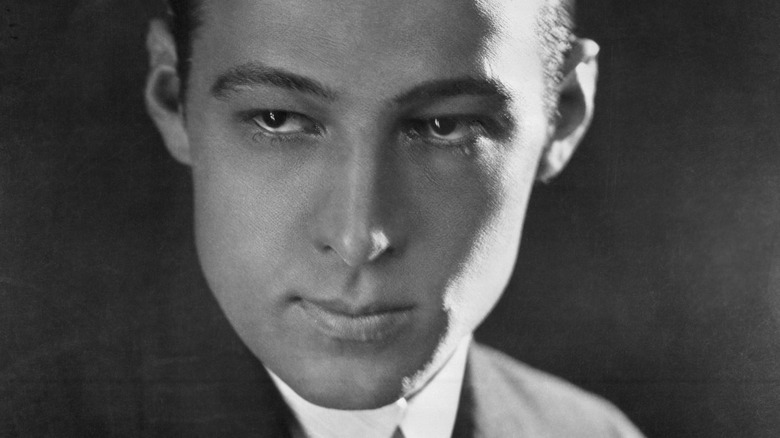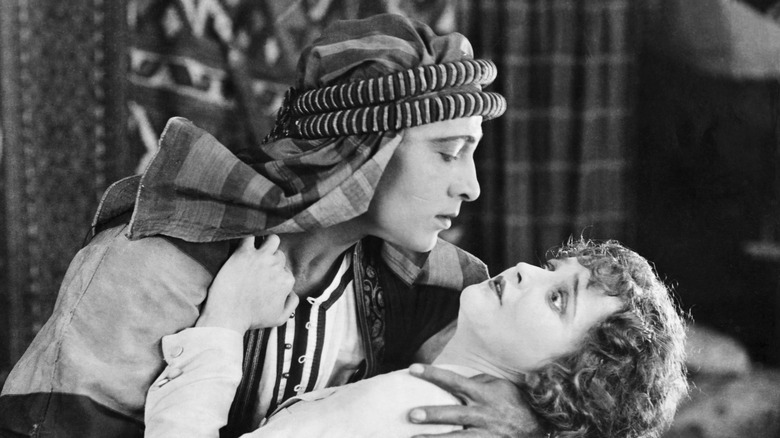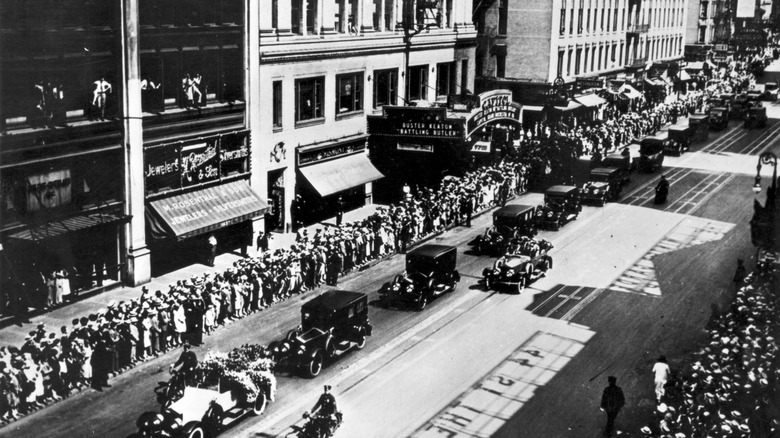The Tragic 1926 Death Of Rudolph Valentino, Hollywood's 'Latin Lover'
Rudolph Valentino lay in a bed at the Polyclinic Hospital in Midtown Manhattan. It was the morning of August 23, 1926, and the silent movie star had been at the hospital for more than a week. He collapsed in his hotel room at the Hotel Ambassador on August 15, gasping and doubling over in pain before passing out, according to the Associated Press. Valentino underwent emergency surgery for a burst gastric ulcer and an appendectomy. Doctors held out hope he'd pull through, but peritonitis set in, per Britannica. While a private detective stood guard outside, a Catholic priest pressed a crucifix to the actor's lips, according to The New York Times and "The Valentino Mystique: The Death and Afterlife of the Silent Film Idol."
A few minutes later, Valentino shuddered once and breathed his last. Joseph Schenck, executive director of United Artists, gave the reporters waiting in the lobby the news. "Just passed away," is all he could get out (via "The Valentino Mystique"). It was enough. In a matter of minutes, word had spread through the streets, and the hospital was already surrounded by hundreds of Valentino's fans, requiring the police to come into the lobby and restore order. It was the first of many such scenes surrounding the untimely death of the silver screen's first male sex symbol.
A meteoric rise
Rudolph Valentino was born Rodolfo Alfonso Raffaello Pierre Filibert Guglielmi di Valentina d'Antonguolla in Castellaneta, Italy on May 6, 1895. After immigrating to the United States in 1913 and settling in New York City, he moved to Los Angeles to pursue a career in the burgeoning film business in 1918. With 1921's "The Four Horsemen of the Apocalypse," in which the actor danced the tango, Valentino became a bona fide star and only gained more rabid fans, especially female fans, with his next film, "The Sheik."
His meteoric rise to the top wasn't without some bumps. He left New York City for Hollywood to avoid a scandal after he angered Jack De Saulles, a wealthy elite, by testifying against him in his divorce case with Blanca de Saulles, Valentino's friend — and possible lover (per Vanity Fair). De Saulles used his pull to have Valentino charged with pimping (the police later dropped the charges). Blanca murdered her ex-husband shortly thereafter. Valentino's love life only got rockier on the West Coast. By the time of his death at age 31, he'd been married and divorced twice, faced a bigamy charge for marrying his second wife before his divorce had been finalized, and was reportedly engaged to the actress Pola Negri at the time of his death, per the Los Angeles Times.
A sudden collapse
None of it mattered. Rudolph Valentino's star continued to rise. His final film, 1926's "Son of the Sheik," was even more popular than his earlier films. He had it all — fame, money, love — but there was still something missing. "I have everything — and I have nothing," he once remarked to a reporter (via "The Valentino Mystique"). "It's all too — too terribly fast for me. What am I? Where am I? What is this all about? Where am I going?"
After Valentino's sudden collapse in his hotel room and slow death in a hospital bed from an infection following his emergency surgery, the news of his passing hit all of Hollywood and his legions of fans around the world hard. There were reports that some of his most devoted fans died by suicide upon hearing the news. Valentino lay in state in a silver coffin in Manhattan for several days to allow the tens of thousands of riotous fans to see the star one final time. Valentino had two funerals, one in New York City, which was mobbed by 100,000 fans, and a second funeral in Hollywood. For years afterward, a mysterious woman in black would come to visit his grave on the date of his death.


